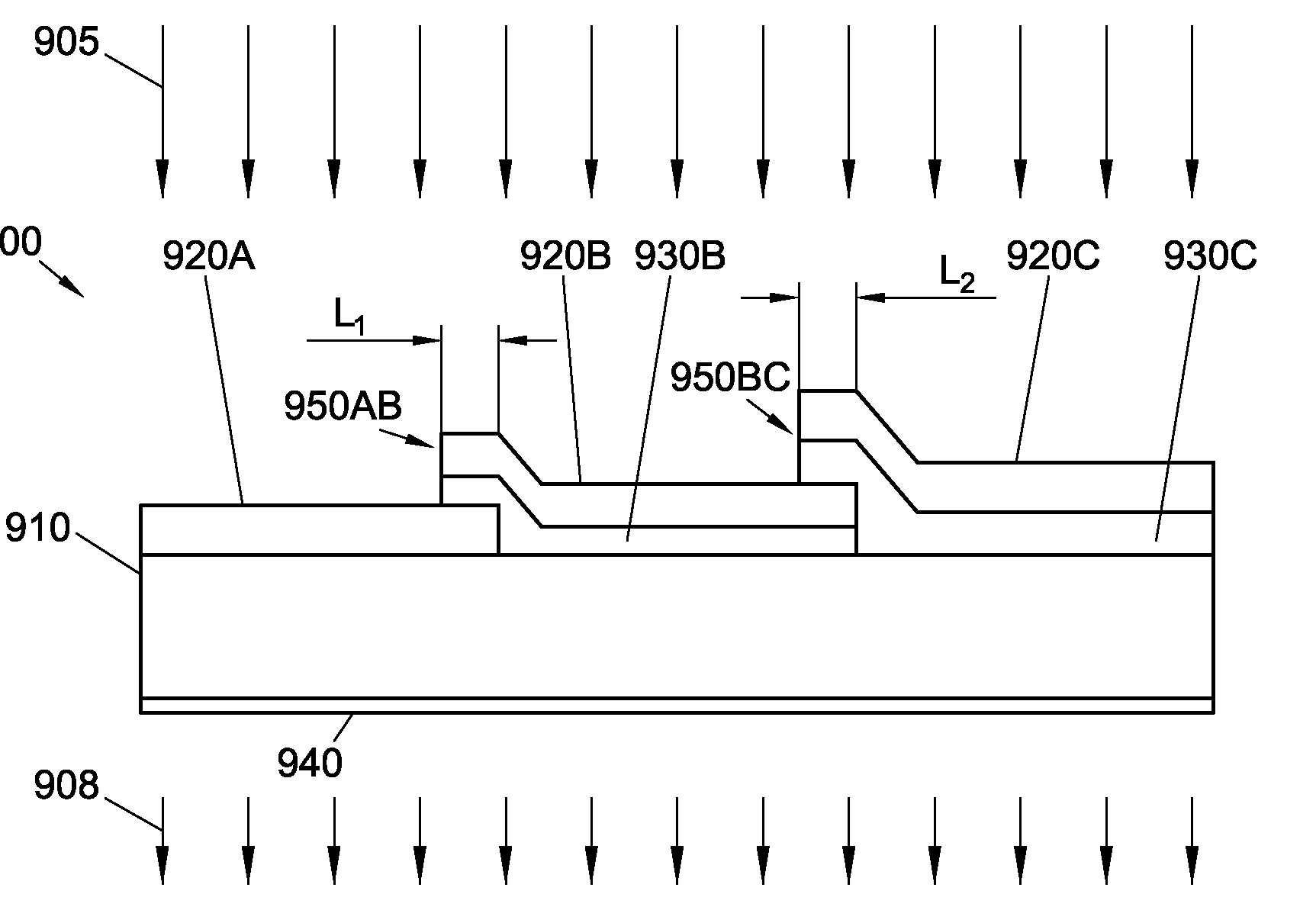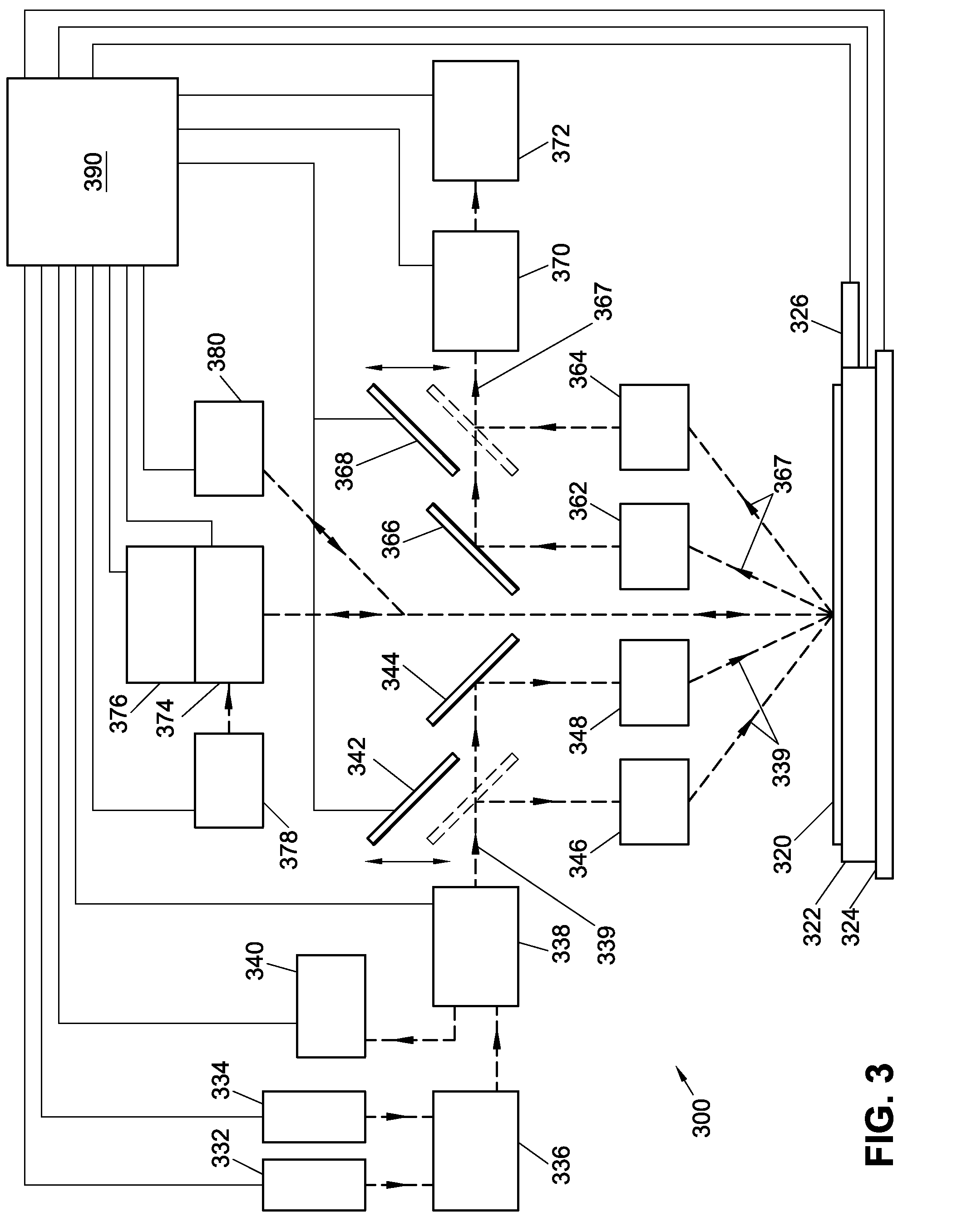Diffraction order sorting filter for optical metrology
a filter and optical metrology technology, applied in the field of optical metrology, can solve the problems of unplanned light dispersion, anomalous diffraction signals measured at wavelengths in the vicinity of joints between osf zones, and overlapped diffraction orders generated by gratings
- Summary
- Abstract
- Description
- Claims
- Application Information
AI Technical Summary
Benefits of technology
Problems solved by technology
Method used
Image
Examples
embodiment 800
[0054]FIG. 8 shows an embodiment 800 of, for example, order sorting filter (OSF) 570 of FIG. 5. OSF 800 has three zones, whose passbands are determined by thin-film stack filters 820A, 820B, and 820C respectively, all deposited on a common optically-transparent substrate 810. The optically-transparent substrate 810 can be made of DUV grade silica, to allow for high transmission in the UV and DUV parts of the spectrum, but other materials can also be used, such as various types of glass, quartz, calcium-fluoride, sapphire, etc. An antireflective coating 840 may be applied to the side of optically-transparent substrate opposite the thin-film stack filters 820A, 820B, and 820C, to minimize light reflections at the substrate-to-air interface. Thin-film stack filters 820A, 820B, and 820C are made of multiple thin films, whose thicknesses and materials determine their passband.
[0055]The process of designing thin-film stack filters given a set of known passband requirements and other const...
embodiment 900
[0059]FIG. 9 shows an embodiment 900 of, for example, order sorting filter (OSF) 570 of FIG. 5. OSF 900 has three zones, whose passbands are determined by thin-film stack filters 920A, 920B, and 920C respectively, all deposited on a common optically-transparent substrate 910. The optically-transparent substrate 910 can be made of DUV grade silica, to allow for high transmission in the UV and DUV parts of the spectrum, but other materials can also be used, such as various types of glass, quartz, calcium-fluoride, sapphire, etc. An antireflective coating 940 may be applied to the side of optically-transparent substrate opposite the thin-film stack filters 920A, 920B, and 920C, to minimize light reflections at the substrate-to-air interface. Thin-film stack filters 920A, 920B, and 920C are made of multiple thin films, whose thicknesses and materials determine their passband.
[0060]Incident light beam 905 is transmitted through thin-film stack filters 920A, 920B, 920C, the optically-tran...
embodiment 1000
[0063]FIG. 10 shows an embodiment 1000 of, for example, order sorting filter (OSF) 570 of FIG. 5. OSF 1000 has three zones, of which the first one does not have a thin-film stack filter deposited thereupon. The passbands of the remaining two zones are determined by thin-film stack filters 1020B and 1020C respectively, all deposited on a common optically-transparent substrate 1010. The optically-transparent substrate 1010 can be made of DUV grade silica, to allow for high transmission in the UV and DUV parts of the spectrum, but other materials can also be used, such as various types of glass, quartz, calcium-fluoride, sapphire, etc. An antireflective coating 1040 may be applied to the side of optically-transparent substrate opposite the thin-film stack filters 1020B and 1020C, to minimize light reflections at the substrate-to-air interface. Thin-film stack filters 1020B and 1020C are made of multiple thin films, whose thicknesses and materials determine their passband.
[0064]Incident...
PUM
 Login to View More
Login to View More Abstract
Description
Claims
Application Information
 Login to View More
Login to View More - R&D
- Intellectual Property
- Life Sciences
- Materials
- Tech Scout
- Unparalleled Data Quality
- Higher Quality Content
- 60% Fewer Hallucinations
Browse by: Latest US Patents, China's latest patents, Technical Efficacy Thesaurus, Application Domain, Technology Topic, Popular Technical Reports.
© 2025 PatSnap. All rights reserved.Legal|Privacy policy|Modern Slavery Act Transparency Statement|Sitemap|About US| Contact US: help@patsnap.com



